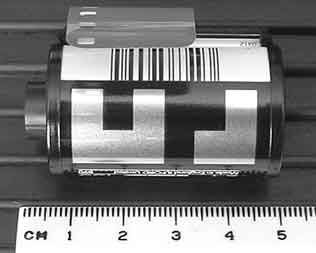DX 인코딩
DX(Digital indeX, 디지털 인덱스) 인코딩(DX encoding)은 ANSI, I3A 표준의 하나로서, 1983년 3월 코닥이 135, APS 포토그래픽 필름과 필름 카트리지의 마킹을 위해 처음 선보였다.

역사
편집35 mm 필름을 135 포맷 코닥에 관리하는 일을 단순화시킬 목적으로 코닥은 DX 인코딩 방식을 1983년 1월 3일에 선보였다.[1][2] 135 포맷 카트리지의 필름 속도 감지에 이미 전기 접점을 사용하였던[3] 1977년의 후지의 필름 속도 인코딩 방식과 같은 이전의 해결책과 대조적으로[4] 코닥의 이후 DX 코드는 즉시 시장의 성공에 부합할 수 있었다.
최초의 DX 인코딩 필름은 1983년 3월의 컬러 네거티브 필름 코다컬러(Kodacolor) VR-1000이었다.
이 기술을 사용한 최초의 카메라는 코니카 TC-X SLR이었으며 그 외에 콤팩트 카메라 펜탁스 슈퍼 스포츠 35 / PC 35AF-M[5]와 Minolta AF-E / Freedom II[6](1984)도 있었다. 대신 펜탁스는 1985년의 A3 / A3000이 최초의 DX 지원 SLR이었다고 주장하였다.[7] 그 밖의 DX 지원 SLR들이 1985년에 선보였다: 미놀타 7000[8](1985년 2월), 9000(1985년 9월), 니콘 F-301 / N2000
DX 카메라 온토 센싱
편집DX 카메라 온토 센싱 코드 읽기
편집| ISO 속도 | 1번째 로우 DX 콘택트 | |||||
|---|---|---|---|---|---|---|
| G | S1 | S2 | S3 | S4 | S5 | |
| 25/15° | ||||||
| 32/16° | ||||||
| 40/17° | ||||||
| 50/18° | ||||||
| 64/19° | ||||||
| 80/20° | ||||||
| 100/21° | ||||||
| 125/22° | ||||||
| 160/23° | ||||||
| 200/24° | ||||||
| 250/25° | ||||||
| 320/26° | ||||||
| 400/27° | ||||||
| 500/28° | ||||||
| 640/29° | ||||||
| 800/30° | ||||||
| 1000/31° | ||||||
| 1250/32° | ||||||
| 1600/33° | ||||||
| 2000/34° | ||||||
| 2500/35° | ||||||
| 3200/36° | ||||||
| 4000/37° | ||||||
| 5000/38° | ||||||
| custom 1 | ||||||
| custom 2 | ||||||
| custom 3 | ||||||
| custom 4 | ||||||
| custom 5 | ||||||
| custom 6 | ||||||
| custom 7 | ||||||
| custom 8 | ||||||
| 노출 | 2번째 로우 DX 콘택트 | |||||
|---|---|---|---|---|---|---|
| G | L1 | L2 | L3 | T1 | T2 | |
| 기타 | ||||||
| 12 | ||||||
| 20 | ||||||
| 24 | ||||||
| 36 | ||||||
| 48 | ||||||
| 60 | ||||||
| 72 | ||||||
| 노출 저항 (단위: F 값) |
2번째 로우 DX 콘택트 | |||||
|---|---|---|---|---|---|---|
| G | L1 | L2 | L3 | T1 | T2 | |
| ±½ | ||||||
| ±1 | ||||||
| +2 −1 | ||||||
| +3 −1 | ||||||
같이 보기
편집각주
편집- ↑ 코닥 press announcement 1-83-1425, 1983
- ↑ 코닥 press announcement 1-83-1427, 1983
- ↑ “Fuji's Latest Auto-System”. 《en:Amateur Photographer》: 61. 1977년 2월 16일. 2018년 1월 22일에 원본 문서에서 보존된 문서. 2011년 7월 21일에 확인함. [1]
- ↑ “US-Patent 4024557: Film magazine having film speed indicating means”. Fuji. Patent 4024557. 2011년 7월 21일에 확인함.
- ↑ “History of Innovations”. 펜탁스. 2012년 3월 28일에 원본 문서에서 보존된 문서. 2011년 7월 21일에 확인함.
1984: Pentax introduces its second leaf-shutter sport model, the Super Sport 35 (PC 35AF-M). The new addition offers all of the features of the Sport 35, plus a built-in auto winder, fully automatic loading and automatic film speed setting using the Kodak-pioneered DX coding system. The Super Sport 35 is the world's first non SLR camera to incorporate the DX film sensing system.
- ↑ “Introduction of the Minolta AF-E / Freedom II in July 1984”. 《Minolta camera history》. Japan: 코니카 미놀타. 2008년 3월 23일에 원본 문서에서 보존된 문서.
- ↑ “History of Innovations”. 펜탁스. 2012년 3월 28일에 원본 문서에서 보존된 문서. 2011년 7월 21일에 확인함.
1985: The Pentax A3000, a fully automatic SLR, is introduced. Its automated features include: exposure, film loading and winding, and film speed setting with DX-coded film. The A3000 was the world's first 35mm SLR camera to utilize the DX film sensing system. This new SLR also allows for creative flexibility with features such as: aperture-priority, backlight compensation and a 12-second self-timer. The camera's Pentax KA bayonet lens mount makes it compatible with more than 50 Pentax lenses.
- ↑ “Introduction of the Minolta 7000 AF in February 1985”. 《Minolta camera history》. Japan: 코니카 미놀타. 2008년 3월 23일에 원본 문서에서 보존된 문서.
- ↑ Paul, Matthias (2005년 10월 22일). “Ausführliche Informationen zum DX/CAS-Code” [Comprehensive information regarding DX/CAS code] (독일어). 2011년 7월 21일에 확인함.
외부 링크
편집- “A Java applet for generating and interpreting DX codes”. 2016년 3월 4일에 원본 문서에서 보존된 문서. 2018년 9월 24일에 확인함.